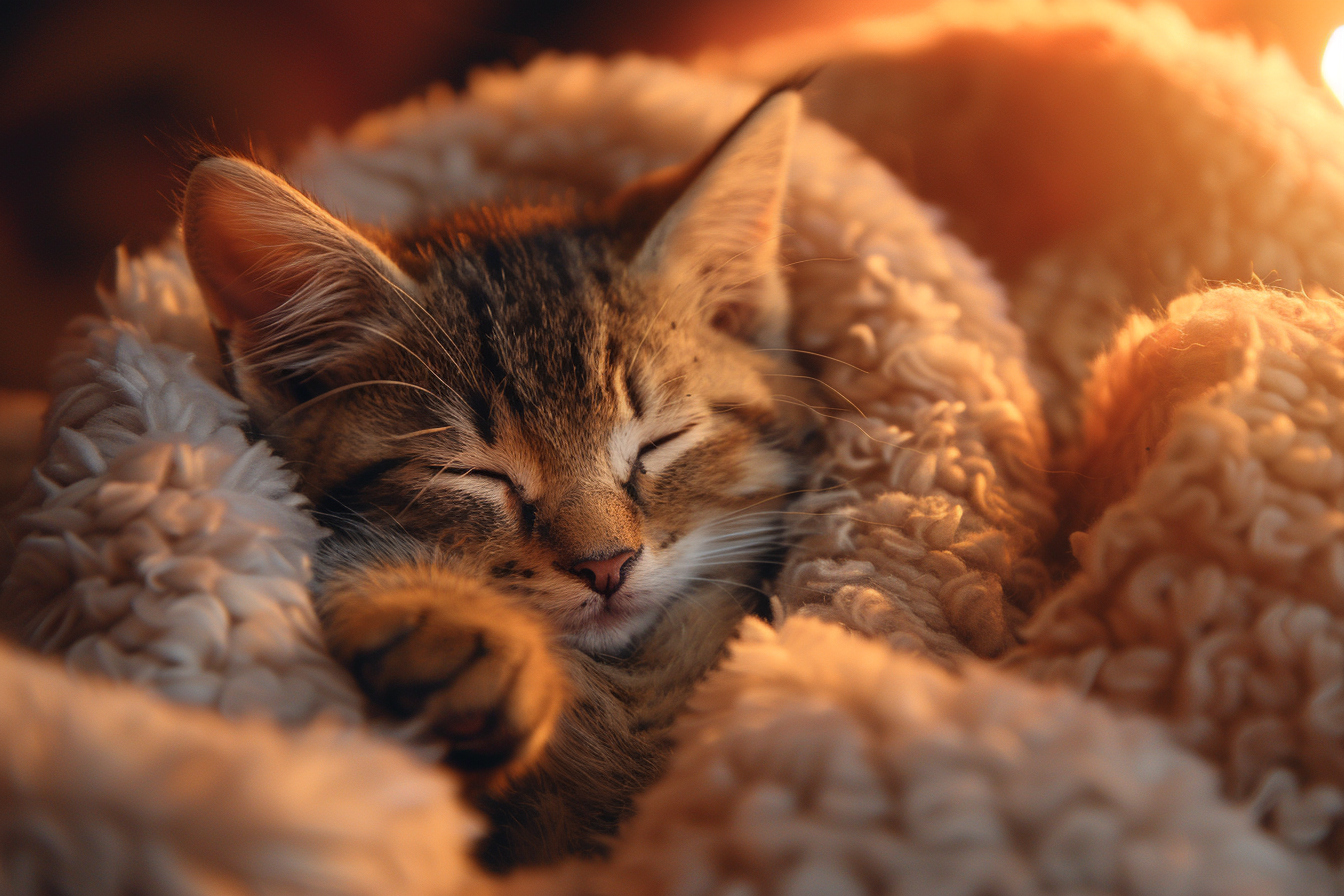Purring. It’s a sound familiarly associated with satisfaction and contentment among our feline friends. But why do kittens purr, and what exactly does that mean? Purrs can encapsulate a range of feelings and biological needs, going beyond the simple expression of well-being.
The sensory and emotional experience of purring
Purring as a means of communication
Kittens are born blind and deaf, the purring then serves as a sound beacon for the mother, facilitating breastfeeding and strengthening the bond between the mother and her little one. This primordial experience engraves in their psyche the association of purring with moments of tranquility and security.
Best Moments of Complicity: Sharing purring moments with your kitten strengthens your relationship. It communicates its tranquility and trust towards you through this calming vibration.
Emotion and purring
Comfort in vulnerability: Kittens often purr when petted or snuggled up to you, revealing their happy state and need for comfort. Purring is an instrument in the orchestra of their emotional communication.
State of serenity: A kitten may purr while sleeping or resting alone, suggesting that purring is a self-soothing sign, like a human child sucking its thumb to self-soothe.
Roles of purring in feline biology
Physiological function of purring
Healing mechanism: Studies suggest that purring may promote healing through its low frequencies, potentially helping with bone and tendon repair, as well as decreasing stress and inflammation.
Breathing aid: Some research has also suggested that purring can help kittens regulate their breathing, especially during resting times.
Implications of purring in kitten development
Social cohesion: In kittens growing in groups, purring serves for social interaction, strengthening bonds between brothers and sisters, as well as with the mother.
Pavement of growth: A kitten’s regular purring can indicate its overall well-being and healthy growth, crucial factors in the first months of development.
Human perception of purring and its impacts
Therapeutic effects of purring on humans
Stress reduction: The kitten’s purring, with its particular frequency, is often perceived as calming by humans, contributing to the reduction of stress and anxiety.
Promotes relaxation: Listening to purring can induce deep relaxation, positively influencing heartbeat and blood pressure in humans, creating a virtuous circle of shared relaxation.
Myths and misconceptions about kitten purring
Purring exclusively linked to contentment
Sign of pain or discomfort: Contrary to popular belief, purring is not always a reflection of ease or happiness. It may also be a sign that the kitten is trying to comfort itself in a situation of pain or distress.
One-dimensional communication
Multifunctional: The interpretation of the purr must take into account its context and may require a nuanced understanding on the part of the owner.
Owners’ commitment to their kitten’s purring
Understanding the nuances of purring
Observe the circumstances: The key to deciphering the meaning of a kitten’s purring is to pay attention to their overall behavior, body language, and the environment in which they are purring.
Knowing how to discern: Recognizing the difference between a contented and distressed purr can improve your ability to meet your kitten’s needs.
Promote an environment conducive to purring
Create a comfort zone: Secure and comfortable spaces encourage purring, a sign of relaxation and comfort for the kitten in its home.
Trust: A strong bond between you and your kitten stimulates his contentment and therefore his audible manifestations of satisfaction.
Future Perspectives on Purr Studies
Research and potential discoveries
The study of purring remains an exciting field, offering future discoveries regarding the physiological mechanisms and mutual benefits between cats and humans.
Improved feline and human well-being
Better understanding of this phenomenon could open doors to new methods of animal and human therapy, as well as a more harmonious relationship between species.
Resonance between humans and their feline companions
Purring is an act more than just making a pleasant sound. It’s a window into the kitten’s mind, a breadcrumb trail leading to their contentment and their physiological and emotional needs. Silent requests for tenderness, whispers of comfort, and suggestions of deeper complicity vibrate in each of these sonic pulses. Whether it is to indicate their contentment or to express more crucial needs, your kitten’s purring remains one of the most touching and enigmatic forms of communication in the animal kingdom.
The continuous symphony of these vibrations is not without effect on us either. It is conducive to the creation of a unique bond, an authentic connection between two species sharing a moment of pure tranquility. Is it possible that in the future, science will reveal other secrets buried in the purrs of these graceful creatures? Only time, research, and our own insight into our furry companions will reveal the true depths of this feline-human practice embedded in our lives. For now, purring remains a sweet mystery, an affectionate echolalia that enchants our daily lives and softens our souls.












